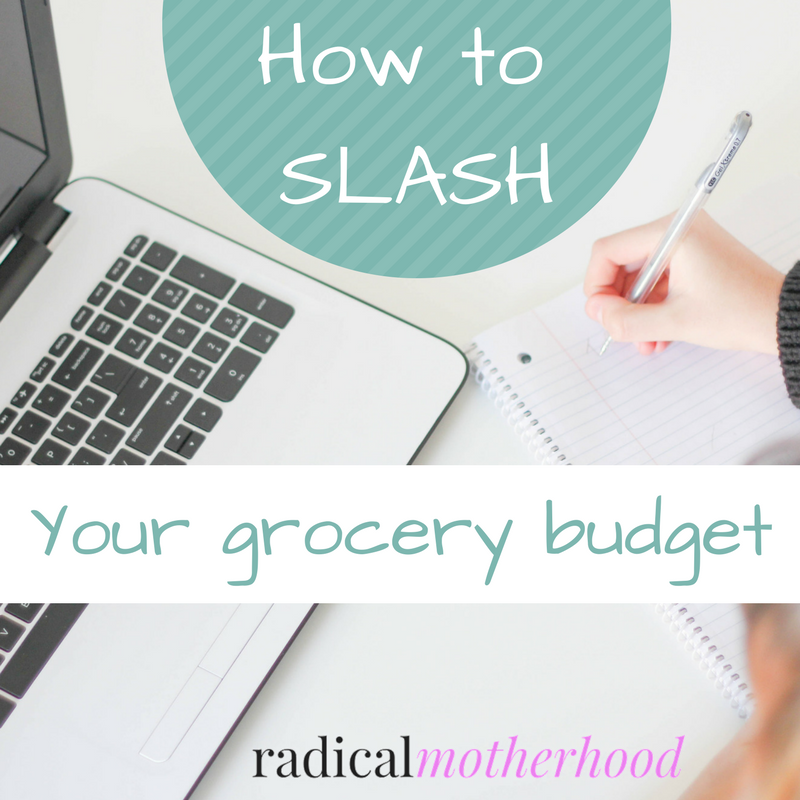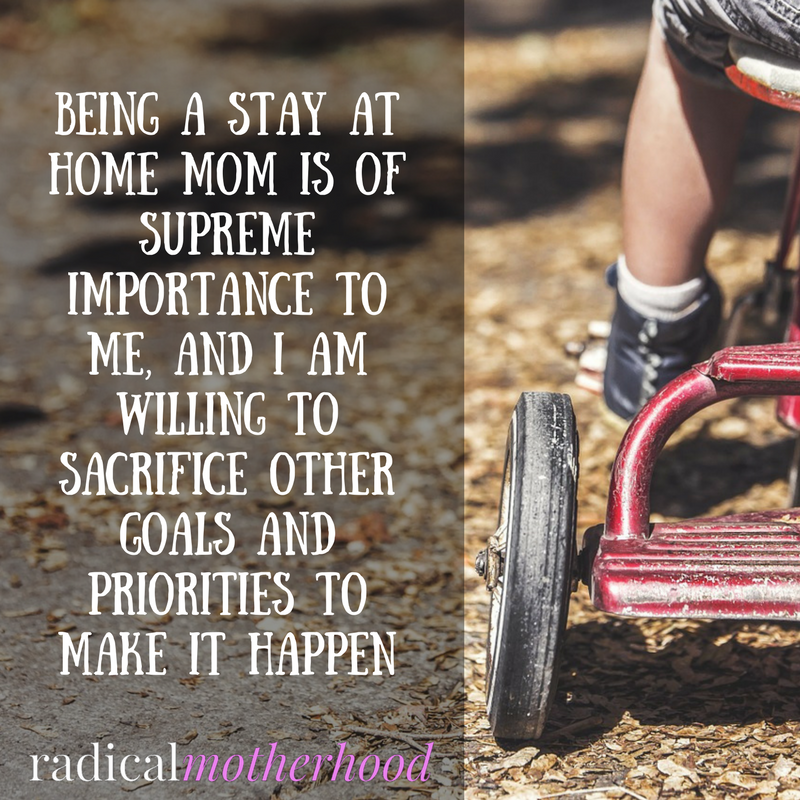Think there’s nothing left in your budget to cut? Think again…
The two biggest obstacles to becoming a stay-at-home mom (in my experience) are:
1. Not understanding the value of your role as mother and household manager
2. Money – fear of not having enough, fear of having to make sacrifices, lack of money-management skills and experience
These are the two main reasons I worked full time – for MANY years – without even considering staying home. I assumed (without really putting a whole lot of thought into it) that we needed two incomes to survive, which just isn’t true for most families. In this post, I’m going to share with you the two-step money management strategy that has had a huge impact on our monthly budget, at a point when I though we were all out of ways to save money and cut expenses. I am regularly saving $500 every month, and I’m actually using less time and less energy than I was before. I’m not talking about selling your car or your house, or cutting out all of the activities and luxuries your family enjoys.
In fact, I’m not talking about making any sacrifices at all. I’m here today to talk to you about…
groceries.
Making two simple (And time-saving! And sanity-saving!) changes to the way I buy groceries has changed my life, and it can change yours too. Changing the way you deal with something as mundane as groceries could be what allows you the financial freedom to stay home. Spoiler alert: THIS IS NOT ABOUT CLIPPING COUPONS. I hate coupons. I am too lazy for coupons, and I never see any coupons for the stuff I actually buy. I like watching coupon shows on TV, but that’s where my interest in coupons ends.
Can you really save big bucks on groceries without coupons?
One reason why I’m writing about groceries and not some other area of our finances is that, for us – and for many families who have been on the path toward more frugal living for any amount of time, the grocery budget is really the only oneleft with any wiggle room. At this stage of our lives (read: many children, few resources), we do not have a vacation budget. Or an entertainment budget. Our clothing budget is next to nothing. We rent, so we don’t need much of a home repair budget. With very small kids at home and a modest income, we have very little money (or desire, frankly) to do things like go out to eat, shop at the mall, or buy expensive…anything. Other than groceries, our discretionary spending is usually less than $100 a month. It was out of sheer desperation to get our expenses lower than our income that I initially resorted to curbing our grocery spending, because it was literally the only category I had left to cut anything out of. However, you do not need to be in our situation to make the changes I’m about to suggest. This grocery strategy will work for anyone, and even if you have an unlimited amount of money to spend, you’ll STILL, for the sake of your own sanity, energy, and well-being, want to implement these changes.
Picture this:
(it’ll probably be easy, because – like me – you’ve probably been through it hundreds of times)
It’s 5:00. You’re done with work (or housework), the kids are done with school, and your husband is due to arrive home from work any minute. You haven’t had any time to think about dinner, and you’re scouring the kitchen for something that you can throw together into a quick meal. The baby is hungry, the toddler is cranky, and the older kids are begging for snacks. You find spaghetti noodles, but no sauce. Hamburger, but no buns or taco shells. One frozen pizza, which is not enough for the whole family. Even cereal is out, because there’s not enough milk. You’re frustrated because you feel like you should have planned better, even though you can’t imagine how you could have possibly found time to do any actual planning. You hate the idea of going to the grocery store, because it delays dinner that much further, it’s always crowded at this time of day, and the idea of actually doing the shopping seems exhausting and overwhelming.
What do you do? I’ll tell you what I would do, and have done, too many times to count: either send my husband to the store for more frozen pizzas the minute he walks in the door (not his favorite thing to do after a long day of work), or to the drive-through for fast food (which all of my kids claim to love, but almost never eat once we get it). Even though it’s not in the budget, it’s not healthy, and it’s not going to do anything to solve the problem of what to eat tomorrow or the rest of the week, it’s the only solution that doesn’t seem completely overwhelming. Sound familiar? I hope not, but I suspect that, on any given day, I’m probably not alone in this last-minute dinner dilemma.
In the past (the not-too-distant past), I’ve really struggled with groceries. I have several problems when it comes to grocery shopping:
1. Our budget is limited. Very, very limited. And we ALWAYS go over it.
2. I have several small children that make going to the store difficult. Very, very difficult.
3. In the grocery store, I’m an impulse shopper, and so are my kids.
4. I hate making shopping lists and frequently forget them at home.
5. I am too lazy and too frazzled to compare prices in the store.
6. I hate coupons.
7. I have always struggled with meal planning for more than a day or two in advance, so I never really know what I’m looking for.
After years and years of doing the same thing (shopping with small children in tow, impulse buying, grabbing whatever is closest vs. what is cheapest, ignoring sales, coupons, and deals, and waiting until the cupboards are bare to plan for the next meal), I have discovered a two-step grocery shopping strategy that has fixed ALL of the problems listed above. Here it is:
1. Meal planning.
Planning your meals just one week in advance will make a HUGE difference in your stress level about dinner and allow you to be more selective in what you purchase. It’s easier and faster (and, dare I say, more fun) than you might imagine.
2. Online grocery shopping and delivery.
This is going to save you time, money, stress, and frustration – you may never want to enter a grocery store again. Did you know that many stores offer free grocery delivery if your order is over a relatively low threshold (my store’s is $100)?
Meal Planning
I have always loved, and feared, the idea of meal planning. It seems so organized and helpful, yet so time consuming and boring. I’ve spent YEARS avoiding it. What if I’m not in the mood for what’s on my plan? Who has time for planning out several meals at a time? Won’t I be buying tons of food in one trip? Won’t that be expensive? What if the food spoils by the time the meal it goes in comes around? Isn’t that only for super-moms? I’m not a super-mom.
Well, let me tell you this:
1. In my experience, meal planning is NOT super time-consuming. In fact, it takes less time to plan out a week of meals than what I used to waste in the store (with whiny kids) looking around and trying to figure out what I was going to make.
2. If I’m not in the mood for what’s on the meal plan, or my kids aren’t excited about it, it’s not a big deal. We either eat it anyway (a great opportunity to exercise self-discipline), or we switch the days around and eat, for example, Tuesday’s meal on Monday and Monday’s meal on Tuesday.
3. I do end up buying a ton of food in one “trip”, but I still do two grocery orders per week, so nothing really has time to go bad. If I’m feeling extra-organized, I move the meals with sensitive foods (salads, fresh fruits) to the day of or after my grocery purchase. I spend much less time and money by making two big orders than I used to spend when I went to the store every day or every other day.
4. I spend way less money by using a meal plan, even though I shop at a more expensive grocery store (because it’s the only one around with grocery delivery). I’m far less likely to impulse-buy when I have a meal plan (and online shopping seriously limits impulse-buying as well, which I’ll address later).
5. I am still not a super-mom, but I don’t need to be. This method of shopping and eating is EASIER and LESS STRESSFUL than winging it. I spend zero time at the grocery store, and I would estimate that ordering groceries online takes about one quarter of the time it takes to travel to the store, do my shopping, load up the van, and travel home. And there is no buckling and unbuckling of carseats, no bickering in the car, no arguments over what ice cream to buy…
How to Meal Plan
Meal planning is not rocket science, but it can be overwhelming if you have picky eaters (I have many of them) or you just plain lack the energy or resources to plan seven meals at once (I do meal plans for dinner only). I have a few solutions for this:
1. Sign up for a meal-planning service, such as E-Meals. I did E-Meals for about 6 months, many years ago, and I printed and saved all of the plans. Now, I just keep them in a binder, and I take one out when I’m getting ready to order groceries for the week. I like E-Meals because the meals have very few ingredients and very simple recipes. (I have no relationship with E-Meals and am not paid to promote or sell their meal plans – I just really like them.) Also, all seven meals are already picked out and organized on one sheet of paper.
2. Take some time to make a list of your family’s favorite meals, and keep the list with your cookbooks/recipes/meal plans. Pick seven of them out just before you’re ready to order groceries for the week.
3. Pick a favorite cookbook and select seven recipes to make for the week. I’ve found that it’s best to stick with one cookbook for all seven recipes, or it gets to be too complicated. Just leave the cookbook on your countertop for the week with the recipes bookmarked, and you’re all ready to go!
After you’ve selected your meals, make a grocery list based on the meals. E-Meals does this for you, and if you’re using your family’s favorite meals, you can create a grocery list for each meal one time, then copy it or type it out and store it with your favorite meal list. Don’t worry about organizing your list; it won’t matter what order you put the ingredients in.
Don’t forget to add breakfast and lunch items to your shopping list (I keep these as simple as possible, and we often eat leftovers for lunch). For breakfast, try having the same thing on the same day each week (Mondays are cereal, Tuesdays are scrambled eggs, etc.), or just keep it simple with a couple of choices offered every day (cereal and toast, or yogurt and fruit, for example).
Also, add in your staple items (milk, bread), your cleaning supplies (vinegar, baking soda), toiletries (shampoo, body wash), and household items (diapers, toilet paper).
I try to keep snack items to a minimum, because I’ve found that if there are snacks around, we will all fill up on those and no one is hungry at meal times. Pre-packaged snacks are expensive, generally unhealthy, and not very filling. I try to use fruit, veggies, cheese, and homemade treats as snacks and avoid things like chips, packaged cookies and granola bars, fruit snacks, etc. This is, honestly, a big struggle for my family, and we still have plenty of room for improvement. If you do buy snacks, add them to your cart last, after all the important stuff is in there, and only allow yourself to spend whatever is remaining in your budget for that trip.
All in all, it takes me about 30 minutes to select a meal plan and write out my grocery list. I’ve found that I actually enjoy choosing the meals, and my family has really surprised me in what they’re willing to try and what they actually seem to like.
Online Grocery Shopping
I buy stuff online all the time. Christmas presents, school supplies, clothing, furniture – you name it, I have probably bought it online. I buy stuff on Amazon, eBay, store websites (like Justice or L.L. Bean), Walmart.com, and even from Facebook groups and Craigslist. I enjoy shopping online and am very comfortable with it. My husband, on the other hand, has NEVER bought anything online. Not once. To him, online shopping is scary (Is this site legit? Is someone going to steal my credit card? Am I going to accidentally spend hundreds of dollars or purchase the wrong thing?). When it comes to your comfort level with online shopping, you may be like one of us, or you may be somewhere in between. I encourage you to at least try buying your groceries online ONE time. I can’t guarantee that you won’t make a mistake, or that your credit card information is 100% safe, or that you’ll love it as much as I do. But, I can guarantee that you won’t know whether it’s right for you unless you give it a try. In all my years of online shopping, I have never had any significant problems. Minor problems, like getting the wrong size, are usually easily remedied (often more easily than going to a physical store). Major problems, like accidentally spending way more than I meant to or having my identity stolen, have never happened to me personally, although I know that they do happen. I’ve had my credit card number stolen a couple of times, but there’s no way for me to know exactly how that happened, and I have heard (although I can’t prove this) that your credit card information is actually much less safe in the hands of your waitress at a restaurant than it is online. If you’re uneasy about online grocery shopping, do some research, and talk to your grocery store manager about your concerns. Have a friend or family member who is experienced in online shopping place your first order with you, so they can answer your questions as you go along. I use Hy-Vee to order my groceries, and it’s as simple as this:
1. Create an account on the website. This involves setting up a username and password and giving the company your email address.
2. Log in using your new username and password. Select your location and whether you want pick-up or delivery. At Hy-Vee, both pick-up and delivery are free if your order is over $100 (so I always choose delivery!).
3. Find your grocery items and add them to your cart. What I do is type my item in the search field (such as, “banana”), then scroll through all the options that appear. I almost always look for the cheapest option, whether it’s on sale or the store brand. Hy-Vee not only has a store brand, but they also have an even cheaper brand called “That’s Smart” for many staple items. My favorite part of online shopping is that I’m able to comparison-shop effectively. If I need to find out which brand is cheaper based on the cost-per-ounce, I just pull up my computer’s calculator. I am not pressured by my kids, or pretty packaging, or the arrangement of the items, to choose the most expensive option. If you’re into coupons, you can even use digital coupons (I really, really hate coupons, so I’m not exactly sure how that all works, but I know it’s an option, and some items will actually tell you there’s a coupon available). I do use Hy-Vee’s rewards card, which lets you earn money off of your fuel purchases at participating gas stations. On their website, all of the fuel savers are clearly marked, and you just add them to your cart.
One word of caution on rewards cards: make sure you’re not buying expensive items just to earn rewards, because you probably aren’t actually saving any money. For example, if a $4 box of cookies is a $0.20 fuel saver reward, that sounds like a great deal. However, if I buy the maximum amount of fuel with my card (20 gallons), I save $4.00 (20 gallons x 20 cents), which is exactly the cost of the cookies I didn’t need and probably wouldn’t have otherwise bought. Anyway, by limiting what I can see to the item I typed in the search field, I’m not tempted to buy things that, in the store, would be right next to what I’m looking for. I don’t buy mangoes when I’m shopping for bananas, or fancy hummus when I’m shopping for chips, because they aren’t on my list and they aren’t on my screen. Impulse shopping is pretty much a thing of the past. Also, my shopping list doesn’t have to be very organized. When I bring a shopping list to the store, I’m always circling around and around because I didn’t write my list in the same order as the aisles in the store. So, if milk is at the end of the list but in the first aisle of the store, I have to go all the way back there to get it. Big time waster, plus that usually means a trip back by all the snacks that the kids have been begging for.
4. When you’re all done, you choose a delivery or pick-up time, and then you “check out.” Checking out involves entering your credit card and/or gift card information and submitting your order. You can choose to have Hy-Vee remember your credit card information (so you don’t have to keep entering it every time), or you can skip that option if it makes you nervous.
5. You will get a confirmation email with a receipt when your order has been processed. You will also get an email when your order is ready for pick-up or delivery.
6. If you selected delivery, Hy-Vee will show up at your door during the 1-hour delivery window you chose. If you selected pick-up, you just drive to the store during the 1-hour pick-up window, park in the pick-up spot, and call them from your cell phone to let them know you’re there.
7. With your order, you will get a printed receipt, and you will be asked to sign off on the order to verify that it was correct and you received it.
Notice that I skipped the part about establishing a grocery budget. I think the best way to do this, to start, is to look at the previous month’s actual spending and shoot for 80% of that for this month (thereby cutting out 20%). Divide that monthly total by 4.3 for your weekly budget total. I’ve also used the “$100 per person per month” rule. You’ll probably have to play with this number for a while, so just pick a number that seems reasonable and start from there.
The absolute best part of this system is that I have done it all in my pajamas, at home, while my husband takes care of the kids. I have no distractions and no stress. It’s almost like a little bit of “me-time.” I stick to my $900/month budget, when I used to regularly spend up to $1,300+ per month. We almost never get fast food anymore, unless it’s something we’ve planned into our schedule. I don’t have to spend an hour staring at my pantry panicking about what to make. I am actually using my crockpot. My kids are trying new foods. My husband can relax after work. An added bonus for us is that 2 of my kids attend a private school (have no illusions – it’s very inexpensive as far as private schools go, and we have grants that help immensely with the tuition), and the school offers a “Scrip” program. I don’t know what that stands for, but it’s basically a website where you order gift cards, and a percentage of what you spend on the gift cards is deducted from your tuition bill. So, I buy $200 in Hy-Vee gift cards each week, and I earn a 3% rebate toward my kids’ tuition. It doesn’t sound like much, but between that and some other gift cards (like gas cards, for example), I’m hoping to knock $500 off their tuition this year. If your kids attend a private school, be sure to check into this, because every penny truly does count. Each week, when I place my grocery order, I also place my Scrip order. Easy-peasy.
If you’re on the fence about staying home because of money concerns, or if you’re already staying home but think you may have to go back to work because you just can’t make ends meet, THIS IS THE SOLUTION! Stop feeding your family the hard way and take these two easy, painless steps toward financial freedom.
Are you up for a grocery budget challenge? Try doing meal-planning and online grocery shopping for just one month – or even one week – and let us know how it goes! Compare your spending and stress level during the challenge week/month to the one before. If you’re like me, this will change your entire life – and I am not exaggerating. Leave us a comment below and let us know how this system (or your own system) works for you!








Great suggestions! It takes planning and effort to save money on groceries. You’re totally right! Meal planning, freezer cooking, and having some standby meals are great ways to get meals on the table for less!
Regards:
Asian Grocery Online Canada